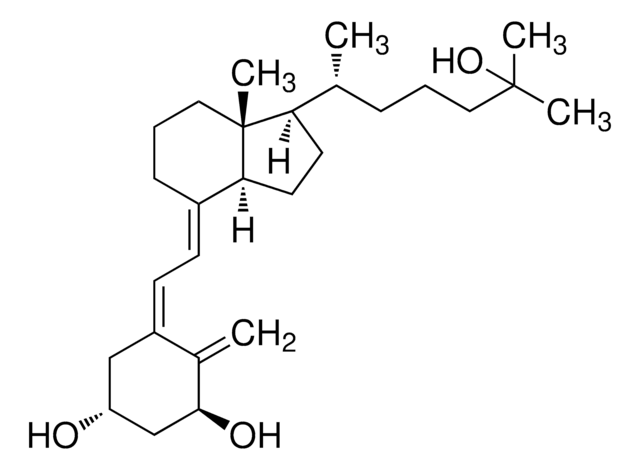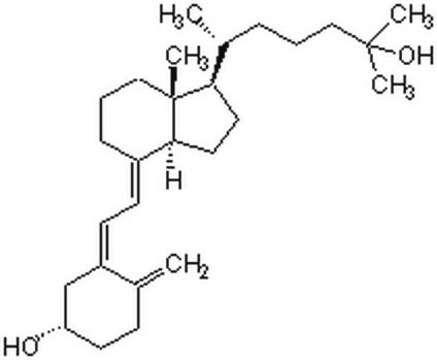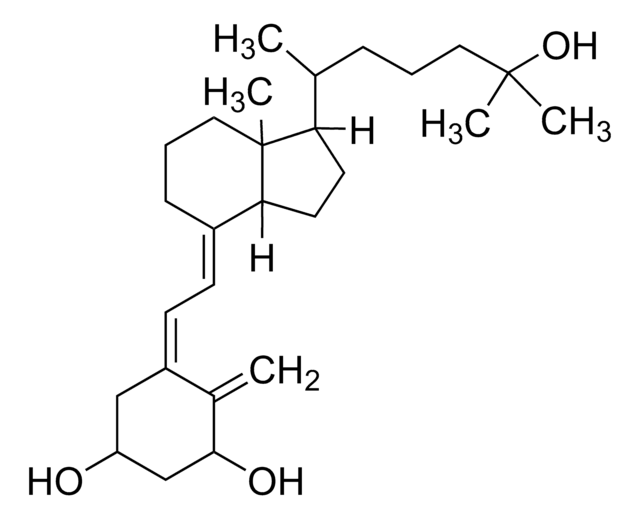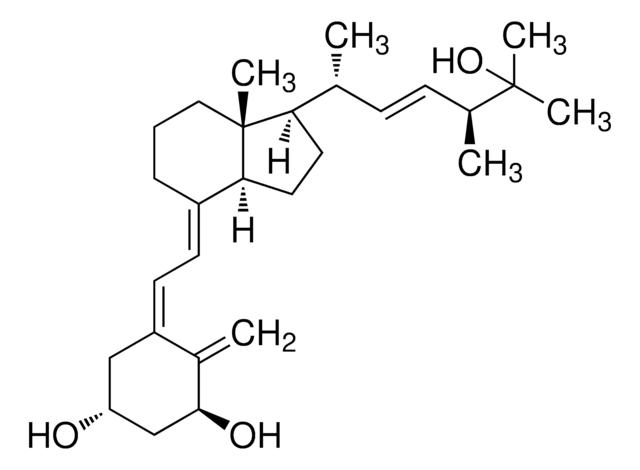679101
Vitamin D3, 1α, 25-Dihydroxy-
CAS 32222-06-3 prevents the development of clinical diabetes in NOD mice, an animal model of human autoimmune diabetes.
Sinonimo/i:
Vitamin D3, 1α, 25-Dihydroxy-, 1,25-(OH)₂-D₃, Calcitriol
About This Item
Prodotti consigliati
Livello qualitativo
Descrizione
Merck USA index - 14, 1644
Saggio
≥95% (HPLC)
Stato
solid
Produttore/marchio commerciale
Calbiochem®
Condizioni di stoccaggio
OK to freeze
protect from light
Solubilità
DMSO: 50 mg/mL
ethanol: soluble
Condizioni di spedizione
wet ice
Temperatura di conservazione
−70°C
Stringa SMILE
O[C@H]1C[C@@H](C(=C)\C(=C/C=C2/[C@H]3[C@@]([C@H](CC3)[C@@H](CCCC(O)(C)C)C)(CCC/2)C)\C1)O
InChI
1S/C27H44O3/c1-18(8-6-14-26(3,4)30)23-12-13-24-20(9-7-15-27(23,24)5)10-11-21-16-22(28)17-25(29)19(21)2/h10-11,18,22-25,28-30H,2,6-9,12-17H2,1,3-5H3/b20-10+,21-11-/t18-,22-,23-,24+,25+,27-/m1/s1
GMRQFYUYWCNGIN-NKMMMXOESA-N
Descrizione generale
Applicazioni
- Vitamin D deficiency or resistance and hypophosphatemia.: Discusses the complex interplay between vitamin D metabolism and phosphate homeostasis, emphasizing the crucial role of 1α,25-Dihydroxy-vitamin D3 in managing and understanding bone mineral disorders and their systemic implications (Sarathi et al., 2024).
- Altered Expression of Vitamin D Metabolism Genes and Circulating MicroRNAs in PBMCs of Patients with Type 1 Diabetes.: Investigates how 1α,25-Dihydroxy-vitamin D3 influences gene expression and microRNA profiles in peripheral blood mononuclear cells, linking vitamin D status with autoimmune processes in diabetes (Al-Nakhle et al., 2023).
- 1α,25-Dihydroxyvitamin D(3) Improves Follicular Development and Steroid Hormone Biosynthesis by Regulating Vitamin D Receptor in the Layers Model.: Demonstrates the role of 1α,25-Dihydroxy-vitamin D3 in enhancing reproductive functions and hormonal balance through its action on the vitamin D receptor, providing insights into fertility management (Cheng et al., 2023).
- 1α,25(OH)(2)D(3) Promotes the Autophagy of Porcine Ovarian Granulosa Cells as a Protective Mechanism against ROS through the BNIP3/PINK1 Pathway.: This study presents the protective effects of 1α,25-Dihydroxy-vitamin D3 on ovarian cells under oxidative stress, suggesting mechanisms that could be exploited for therapeutic interventions in reproductive health (Wang et al., 2023).
Confezionamento
Attenzione
Ricostituzione
Altre note
Hannun, Y.A. 1994. J. Biol. Chem.269, 3125.
Mathieu, C., et al. 1994. Diabetologica37, 552.
Thomasset, M. 1994. Pathol. Biol. 42, 163.
Horton, W.E., Jr., et al. 1991. J. Biol. Chem.266, 24804.
Larsen, C.G., et al. 1991. Biochem. Biophys. Res. Commun.176, 1020.
Thavarajah, M., et al. 1991. Biochem. Biophys. Res. Commun.176, 1189.
Wakasugi, M., et al. 1991. Prostaglandins42, 127.
Matsumoto, K., et al. 1990. Biochem. Biophys. Res. Commun.166, 916.
Simpson, R.U., et al. 1989. J. Biol. Chem.264, 19710.
DeLuca, H.F., and Schnoes, H.K. 1983. Annu. Rev. Biochem.52, 411.
Note legali
Avvertenze
Danger
Indicazioni di pericolo
Consigli di prudenza
Classi di pericolo
Acute Tox. 1 Oral - Acute Tox. 2 Dermal - Acute Tox. 2 Inhalation - STOT RE 1
Codice della classe di stoccaggio
6.1A - Combustible acute toxic Cat. 1 and 2 / very toxic hazardous materials
Classe di pericolosità dell'acqua (WGK)
WGK 2
Punto d’infiammabilità (°F)
Not applicable
Punto d’infiammabilità (°C)
Not applicable
Certificati d'analisi (COA)
Cerca il Certificati d'analisi (COA) digitando il numero di lotto/batch corrispondente. I numeri di lotto o di batch sono stampati sull'etichetta dei prodotti dopo la parola ‘Lotto’ o ‘Batch’.
Possiedi già questo prodotto?
I documenti relativi ai prodotti acquistati recentemente sono disponibili nell’Archivio dei documenti.
I clienti hanno visto anche
Il team dei nostri ricercatori vanta grande esperienza in tutte le aree della ricerca quali Life Science, scienza dei materiali, sintesi chimica, cromatografia, discipline analitiche, ecc..
Contatta l'Assistenza Tecnica.










